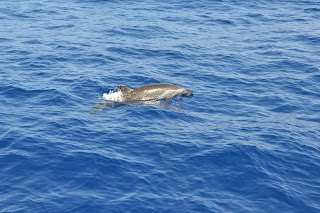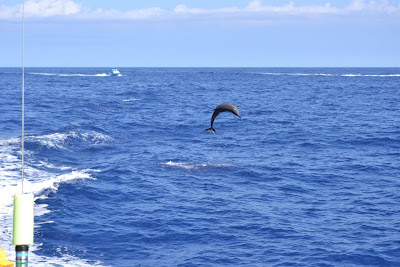 |
Prepping the boat at 6:00am
(Photo: M. Kaplan) |
Today was the first of 17 days out on the water. We left the harbour at 6:30am aboard the Wild Whale, a 27' Boston Whaler, and headed south in search of our target species.
 |
Scanning for whales
(Photo: M. Kaplan) |
As we were leaving the harbour, Robin Baird, one of our collaborators from
Cascadia Research Collective, described the method of scanning the water for whales. Each of us on board was given a section of the boat - for example, from 12 o'clock to 6 o'clock - to survey for the day. So the 7 people on board were each responsible for an area, which overlapped with someone else's designated area.
When someone spots a whale, they shout out the location, distance from the boat, number of animals and the direction that they are heading in. And then everyone springs into action, some people grabbing cameras to take close-up shots of dorsal fins for photo-ID catalogues while others pick up the clipboard to record the sex, number and estimated ages of the animals, and others still picked up long poles with waterproof video cameras attached to film the whales underwater as they get close to the boat.
Around 11:00am our scanning efforts were rewarded: we came across a group of around 30 pilot whales (
Globicephala macrorhynchus) and immediately got to work. We stayed with this group for just shy of half an hour, and then moved on in search of other species.
 |
A pilot whale "spyhopping"
(Photo: T. Aran Mooney, NMFS permit #15530 to CRC) |
Unfortunately, as they day continued the weather started to deteriorate with big swell and whitecaps, which makes sighting whales very difficult. On our return to the harbour we managed to try out the towfish for the first time, which, after we managed to untangle its rope, worked rather well.
In all, we covered nearly 150 kilometers of tracks, but we only managed to see that one group of pilot whales so have yet to make any acoustic recordings.
I included some of the video here that I shot using a GoPro in an underwater housing - unfortunately the quality has been degraded by uploading it, but I am working on putting together a clip with more footage. We hope to use this system to look at how animals react to being tagged and potentially to follow false killer whale predation of fish at the surface (Video: M. Kaplan, NMFS permit # 15530 to CRC).
Once back on land we got straight to work prepping the DTAGS and DMONs for tomorrow and again trying to fix the drifter buoy. Almost there, I think. We have two boats tomorrow, which should improve our chances of seeing our target species.

































